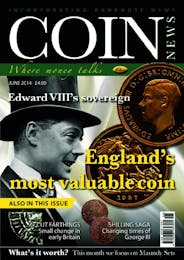Pound for pound?
SO in a few months’ time we will know whether Alex Salmond gets a seat at the top table as head of an independent Scotland or whether the Bravehearts of the 21st century are doomed to fade into the background (until, perhaps immortalised by Hollywood—although I’m not sure who they would get to play Mr Salmond — I venture not Mel Gibson . . .). Now I’m not going to weigh in to this particular debate on one side or the other (not that anyone would be interested, it’s headline news when certain media barons pitch in to an argument—I’m not quite there yet). However, there is one aspect of it that interests me, and I dare say you too—the question of Scottish currency. The pros and cons of Scotland keeping the pound are well documented (personal opinion—if they want independence it has to be all or nothing not a cherry pick scenario) but whilst it may be impossible for Edinburgh to keep Sterling as part of a currency Union there is no reason why the Scots can’t have their own “pound” or similar pegged to the rest of the UK (RUK). This is, of course, assuming they don’t immediately join Europe as an independent country—if that were to happen, and their economy was as strong as they are promising it will be, then Scotland would have to join the Euro.
If the Scots were to adopt their own version of the pound — let’s call it the Spound for now — then there is precedence for such a move. The Irish had their own pound long before they were part of the United Kingdom and after the creation of the Irish Free State they went back to it, with its value pegged to the UK£. This even followed into decimalisation and the link only ended with Ireland’s entry into the European Monetary System in the 1970s. From thereon in whilst the “Punt” was, broadly speaking, the same value as a UK£, there were potentials for variation. However, whether the Irish Pound and UK£ were pegged or not, one thing was very different—the design of the coins and notes.
Now the Scots have had their own notes since 1826 so it is reasonable to assume that the design of the new Spound notes will stay broadly the same as today—but what of the coins? A recent report, submitted to the Scottish Parliament by economist Professor Gavin McCrone, has suggested that it is perfectly possible for the Scots to follow the Irish example and implement a pegged Spound, which he suggests might be called the Merk after a coin minted in Scotland in the 1500s (it was worth, apparently, 13 shillings and fourpence—two thirds of a pound). This report, and the suggestion of looking to history to choose the currency, inevitably led to a series of articles on-line and in the press regarding what coins the Scots could adopt—these included the Unicorn and the Testoon, both of which will be known to Scottish numismatists. Other suggestions—such as the “Bucky” (named after Buckfast Tonic Wine) and the Connery (named after Sean) went on to show the articles were not necessarily taking the idea that seriously. But it is a serious matter. If the Spound is introduced what will go on the coins and what will the denominations be?
The Irish had the sense to keep everything bar the designs the same so there was no confusion as to what was worth what and it would seem logical for the Scots to do the same; however, the mood amongst the SNP does seem to be one of ridding themselves of as many things English-related as possible so a move towards the coins of old cannot be ruled out. I note that one intrepid private organisation is already ahead of the game with their own pattern “Ryals” for Scotland—whether they are adopted remains to be seen…! It is, judging by the latest opinion polls, unlikely that this will ever really be an issue as Scotland looks set to stay in the Union, but even if it does it is distinctly possible that the pro-independence won’t give up and may well push to have more Scottish-related designs on coins anyway. There has always been a strong Scottish influence on our coinage (I’m thinking, in particular, of the George VI shillings) and whatever the outcome of the Referendum, that is likely to continue. So, whether Scotland stays with the RUK, goes it alone or joins the Euro, it is likely that we will see a raft of new designs circulating on coins in Scotland—exciting times ahead for numismatics north of the border! Oh, and for the record, I thought of the name “Spound” first so if the Scots do adopt it I want a cut . . .!

Archives
-
2024 (7 articles)
-
2023 (35 articles)
-
2022 (19 articles)
-
2021 (31 articles)
-
2020 (45 articles)
-
2019 (26 articles)
-
2018 (28 articles)
-
2017 (25 articles)
-
2016 (23 articles)
-
2015 (21 articles)
-
2014 (30 articles)
-
2013 (31 articles)
-
2012 (44 articles)
-
2011 (36 articles)
-
2010 (50 articles)
-
2009 (38 articles)
-
2008 (47 articles)
-
2007 (34 articles)
-
2006 (31 articles)
-
2005 (12 articles)
-
2004 (6 articles)
-
2003 (11 articles)
-
2002 (5 articles)
-
2001 (5 articles)









